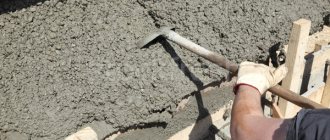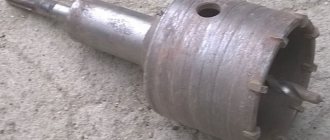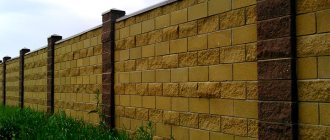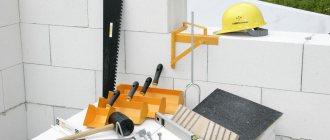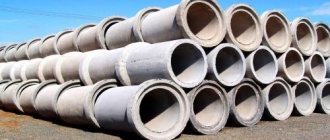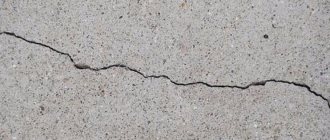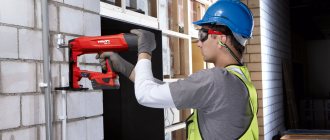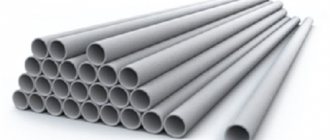Cutting reinforced concrete with diamond wheels, for which an electric circular saw is used, is the most effective method for such processing of concrete structures, but it is not always available and applicable. In conditions of difficult access or lack of power supply, a concrete chainsaw can be used to cut stone, and we want to talk about it in more detail.
The concrete chain saw allows you to cut concrete products and monolithic structures.
Concrete cutting saw
Device and purpose
Petrol cutters are used for dismantling work.
A hand saw for cutting concrete can greatly facilitate the processing of reinforced concrete, stone, composite, brick and monolithic structures during all kinds of construction work. As a rule, wall saws with diamond blades are used for cutting reinforced concrete, but their use is not always available.
The fact is that the weight and dimensions of such machines are quite large, and therefore they cannot be used in hard-to-reach places, confined spaces, for high-altitude work in industrial mountaineering and other similar areas. Hand-held circular saws do not allow cutting to a sufficient depth.
Wall saws are often too bulky and heavy.
Therefore, when carrying out work using wall cutters and other heavy equipment, hand-held chain saws are always used. The reciprocating design of the cutting set allows you to work at a sufficient cutting depth - 30 - 40 cm, in addition, it allows the end entry of the saw and cut with a 90-degree rotation, which is important when constructing openings and niches.
A band saw for foam concrete allows you to cut to a sufficient depth.
The main cutting tool of the device is a diamond chain stretched on a special tire, which drives and guides the chain. The chainsaw chain for concrete has special soldering in the form of diamond-coated segments, which makes it more durable and efficient.
The bar and chain are detached from the saw like a headset, which simplifies the maintenance and repair of the tool.
The device has a power unit - a gasoline or electric engine.
Electric chain saw for concrete.
The gasoline unit, as a rule, has a two-stroke operating principle and is protected from moisture and dust. Torque is transmitted to the chain using a clutch or gearbox; most often, modern tools have an automatic centrifugal clutch, which allows you to immobilize the chain at idle speed or stop it when jammed and other emergency modes.
The tire of a chainsaw for stone differs from the tire of a regular chainsaw for wood. It is more complex due to the channels through which water flows to the circuit. Water is necessary to cool the cutting belt and remove concrete-sand sludge and chips, without which the chain will not be able to work for a long time.
The bar and chain are removed from the device.
If the tool is equipped with an electric motor, then this is usually a brushed single-phase unit running on alternating current 50 Hz and 230 V. The power of the electric motor can range from 1 to 3 kW, sometimes more powerful machines are also available. Particular attention in the design of electric saws is paid to protecting the engine from water and dust.
Important! Hand-held reciprocating saws for concrete are used for cutting concrete, stone, brick or asphalt in hard-to-reach places during construction and dismantling work. It is also advisable to use them for small volumes and sizes of structures.
Application area
Saw on foam concrete at work.
Electric saws and gas cutters for concrete can be used to cut the following materials:
- Cellular concrete , including foam concrete, aerated concrete, gas silicate, foam aerated concrete and similar materials;
- Lightweight concrete , including expanded clay concrete, pumice concrete, perlite concrete, polystyrene concrete, wood concrete, fire concrete and the like;
- Dense and heavy concrete based on Portland cement, asphalt, slag cement, polymer binder and other types of binder. Heavy concrete can be cut with weak reinforcement;
- Sand-lime and ceramic bricks , clinker, building blocks made of foam concrete and other materials;
- A natural stone;
- Porcelain tiles and other types of artificial stone;
- Gypsum, drywall, chalk, limestone;
- All kinds of composite and complex building materials from solid substances.
Read also: Dewalt screwdriver battery repair
These saws are most often used in the following areas:
- Dismantling work to demolish walls, partitions, ceilings, columns, diaphragms, crossbars and other elements of enclosing and load-bearing building structures;
- Work on redevelopment of apartments;
- Construction of additional window or door openings in the walls, as well as adjustment of existing ones during major repairs;
- Finishing corners after disk machines work;
- Cutting niches, holes and openings;
- Laying grooves and cutting niches for socket boxes, laying various channels and communications, as well as ventilation holes and channels;
- Cutting building materials such as concrete blocks, reinforced concrete products and stone, brick, foam concrete and others.
It is especially convenient to cut openings.
Important! The presence of large fittings can become a serious obstacle and require the use of a gas or rotary cutter. The instructions for the tool must indicate the limits of applicability of the device.
Since you work with the tool yourself, it is important to remember about safety precautions and protective equipment - gloves, glasses and a helmet. Although the device is relatively safe, the cost of ignoring these rules may be too high.
What to look for when choosing
To choose a quality tool, you need to understand its technical characteristics!
When purchasing a concrete cutter, the following parameters are significant:
- Power (determines the performance of the model).
- Cutting depth (between 97 and 260 millimeters).
- The quality of the built-in air purification system (in particular, the filter system).
- The time it takes for the engine to start.
- Tool weight.
- Inclusion of systems that ensure safety during operation (durable protective casing and option to lock the disk in the event of a jam).
- The degree of vibration of the tool and the ergonomics of the handle.
The cutter is selected based on the amount of work that the master has to do. The material to be processed and the frequency of manipulations are taken into account. Petrol cutters process two types of materials – metal and concrete. To cut concrete, a tool with more power (more than 4.2 kW) is required.
Expert opinion
Kuznetsov Vasily Stepanovich
The most convenient is a light weight gas cutter with a low vibration level. It allows you to cut concrete at high speed and fits comfortably in your hand.
Additional characteristics that are also considered when viewing instruments include:
- Manufacturer (products from large manufacturers are more expensive, but are more reliable. These companies include Husqvarna, Stihl and Echo).
- Cutting method.
- Basic equipment.
- Possibility of repairing breakdowns (preferably the presence of branded repair centers).
- Quality of exhaust gas purification from toxic elements.
- Duration of warranty service.
It should be taken into account that different manufacturers are focused on their own categories of consumers. For example, Stihl and Echo are designed for use at home. They are easy to use, but have mediocre characteristics. Models from Husqvarna and Makita are suitable for professionals. Their cost is higher, but it is compensated by quality.
Conclusion
Chain saws for concrete allow you to replace cutting with discs, and sometimes even diamond drilling of holes in concrete. These units are more convenient, lighter and allow you to work in hard-to-reach places. They can be used as a stand-alone tool or as an addition to wall sawing machines (find out here how concrete insulation is performed).
For more visual information, watch the video in this article.
Pobedit is the generally accepted name for all hard alloys for cutting tools. Saws with carbide pobedit teeth have been used in woodworking for a long time and everywhere. But mostly on round saw blades. This material has not previously been used on chainsaw chains. But today such chains are on sale.
The best manufacturers of electric hacksaws
Cutting concrete with a reciprocating saw
The most popular and inexpensive reciprocating saw is the model of the American manufacturer Dewalt DCS380M2. The tool kit does not include a blade; it must be purchased additionally for cutting foam concrete.
Saw model Dewalt DCS380M2
Cheaper instruments are also available. Their quality is not lower than other manufacturers.
Some of the models are presented in the table:
| Hacksaw model | Peculiarities |
| Bosch | The company produces a wide range of electric hacksaws for cutting aerated concrete. The most popular models: GSA 1300 PCE; Bosch GSA 36 V-Li. |
| Makita | The reciprocating saw model JR 3060T is a fairly strong unit with a power of 1250 W. With its help you can easily saw aerated concrete blocks and other materials. |
| Metabo | These are German tools, have high reliability and versatility. |
| Black & Decker | On the Russian market, a German manufacturer offers an electric model for cutting aerated concrete. Disadvantages of equipment: relatively rapid wear of working parts, high cost. Main advantages: ease of use, safety. |
Scope of application
A carbide chain is well suited, and sometimes simply irreplaceable, for sawing hard and super-hard wood. For example:
- bog oak;
- steamed wood, similar in density to bone;
- hardwood of the first cut (from a stump), butt, especially dry and twisted (with twisted fibers);
- dry wood with strong branches;
- wood with ice on the surface or contaminated with sand or soil.
Chainsaws with carbide chains are used for cutting ice for any need, including for creating ice sculptures.
Rescue teams from the Ministry of Emergency Situations routinely use only this type of cutting set, even when they have to clear debris made from ordinary wood. In extreme situations, there is no time to monitor the safety of the chain. Often the cutting edge touches stone, the ground, or metal gets into wood. A regular chain will instantly fail and require replacement, but during an emergency there is no time for this.
Options
Each file has a marking on its surface that characterizes the parameters of the working blade. Let's take a closer look at these characteristics.
Shank type
Most of the files produced have a universal shank. Some products are only suitable for branded saws. To make it easier to understand which tool this file is suitable for, letter markings have been created.
Designations:
- T-shape;
- U-shaped;
- M – Makita company;
- F – Fein standard.
Canvas
The first number following the shank letter indicates the size of the working blade. The next two or more digits indicate the specific size of the instance. The size of the canvas is expressed in millimeters:
- 1 - short, up to 75 mm;
- 2 - average, up to 90 mm;
- 3 - long, up to 150 mm;
- 4 - the longest, more than 150 mm.
The letter after the digital designation is responsible for the size of the teeth in ascending order. You can consider the letters from A to D. The last letter characterizes the additional parameters of the canvas:
- F - bimetallic working part;
- O - narrow back;
- P - precise cut;
- X - progressive tooth pitch;
- R - reverse teeth.
HCS
This abbreviation refers to a blade made of high-carbon steel. HCS files are used for cutting soft materials: fiberboard, chipboard, rubber, plastic, aluminum, sheet or profile metal. Wood files differ in the arrangement of their teeth. Most models are presented in a standard version with the same pitch of the cutting elements. Variable pitch is used to process surfaces with foreign objects, such as nails. The average length of the working part is no more than 400 mm.
H.S.S.
The canvas is presented in a curved and curved form. The design features of the product allow you to make through cuts in the material. The length of the working file is 300 mm. The main manufacturers of HSS sheets are DeWalt and Metabo.
BIM
BIM canvases are made of bimetallic material. These files have increased strength, flexibility, and a long service life. They are used when processing materials of various densities - from aerated concrete to wood with nails.
HM and CV
The HM blade is made of vanadium carbide alloy, the CV blade is made of chrome vanadium steel. Both blades are used for cutting porous materials with increased abrasiveness or hard surfaces: fiberglass, ceramics, aerated concrete, tiles, concrete, steel, fiberglass. CV saws are more wear-resistant than HCS.
Victory chain design
The pobedite chain consists of 3 types of links:
- cutting, a tooth is attached to them;
- leading, their lower part (fang) slides along the groove in the tire;
- figure-eight connecting plates.
These parts are connected to each other with rivets.
The cutting link, in addition to the tooth (cutter) itself, has a protrusion that limits the depth of cut.
That is, a pobedit chain does not differ from a regular one in any way, except for other qualities of the alloy of the cutting edge of the teeth.
How it works
The winner is a difficult-to-manufacture and expensive material. Therefore, not the entire tooth is made from it, but only the cutting edge. It is soldered to the body of the teeth using a copper alloy. Despite the softness of copper, such solders are quite strong and, as a rule, last their entire service life.
On pobedite chains, manufacturers do not use soldering, but make the entire cutting link from carbide.
Design Features
Pobedite chains perform better on more powerful than average chainsaws with high traction force. An ordinary tooth can be compared to a sharply sharpened blade. When it becomes dull, the sharpness can be easily restored by straightening the tooth with a special round file with a stencil for maintaining the angle. The pobedite tooth dulls slowly and imperceptibly. Even if slightly dull, it can still work well for a long time. But then more traction on the chainsaw is required, at least 3-3.5 hp.
Read also: Why is a transistor needed in an electrical circuit?
What are the teeth made of?
A real winner is made using powder metallurgy technology and consists of 90% tungsten carbide and 10% cobalt with a small admixture of carbon. Tungsten and cobalt powder are pressed and then sintered at high temperatures close to melting the metal. Available in the form of plates, often already of a given shape.
The material was created in 1929, and since then, on its basis and according to its principle, many different materials have been created - VK4, VK6, VK8, VK10, T15K6, including those specifically for sawing wood.
Tool Features
Typically, hacksaws for concrete are used when it is necessary to obtain blocks that have non-standard sizes, and they are called additional ones.
The models of hacksaws differ:
- Along the length of the canvas;
- According to the thickness of the steel, which affects the quality of the cut of the part;
- Soldering onto the teeth, it happens on each tooth or every other one.
Manufacturers produce two types of hacksaws:
Electrical. These are more complex and more functional tools. But they can be used if they are available and can be connected to the power grid.
Hand saw for foam concrete
Manual. This is the most versatile tool. It can be used under any conditions, including the absence of a power source. The weight of the product is less than an electric saw, and the cost is much lower.
Popular models of hand saws
Cutting a block with a hand saw
When choosing a tool, you should pay attention to its manufacturer. Some of them are presented in the table:
Some of them are presented in the table:
| Manufacturer and photo of the instrument | Tool Features |
| YTONG | Hand hacksaws from this company are considered one of the most popular. Their advantages:
|
| Anchor | The company produces reliable and wear-resistant hand saws for concrete and has many positive consumer reviews. Advantages of the tools:
|
| Hacksaw for cellular concrete Delta | Product advantages:
|
| Bison | This is the most popular manufacturer on the Russian market. Advantages of the tool:
|
Overview of circuits with pobeditovy soldering
Unlike saw blades, until now, chains with pobedit tips have not become widespread. Neither for domestic use nor in the logging industry. Even powerful chains for harvesters - forestry machines, from fellers to loppers - most often do not have pobedit inserts.
It is important that you should not confuse wood chains with chains for gas cutters for other purposes. For example, today there are diamond-coated chains on sale that are structurally, in size and externally similar to wood chains. They are designed for cutting brick, concrete and even metal. But they are not suitable for chainsaws in terms of pitch, thickness and length, and cannot cut wood. The wood simply smokes and burns from friction, as if drilled with a Pobedit drill.
How to cut?
To destroy large objects, hydraulic shears are used, which are attached to the boom of a crane. Dismantling is carried out without shock vibrations, which ensures the compressive ability of the cutters.
Choosing a tool is an important process when cutting concrete, so study the object before doing so. The thickness of the wall, access to electricity and water play an important role. To cut concrete with a grinder, follow these recommendations correctly:
- A large fraction of concrete filler slows down cutting.
- Small units also have low power, so they are not used for complex tasks.
- The choice of disc also depends on the age of the concrete.
- When performing repairs, wear a protective mask and gloves.
- Concrete cutting without noise and dust is carried out using wet cutting units.
- To speed up the cooling of the disk during a break, it is recommended to remove it.
Which winning chain to choose for your home
However, recently new chains with carbide cutters have appeared on sale, which we have always called and will continue to call Pobedit. Moreover, specifically for household and semi-professional chainsaws. These are Rapid Duro 3 chains, manufactured by STIHL in Switzerland. The chains are without soldering, the entire cutting link is entirely made of hard alloy.
Specifically, these are the chains:
- STIHL 63PD-56E 16 inches long, 1.3 mm thick.
- STIHL 63PD-50E 14 inches long, 1.3 mm thick.
- STIHL Picco Duro 3/8-1.3-57 is the world's first carbide version of a low-profile chain.
Despite the fact that these chains have appeared quite recently, there is already experience in their use. These chains today cost 4-5 times more expensive than regular ones, from 1600 to 2000 rubles. According to reviews, they last about the same number of times longer than usual without sharpening.
For information on the rules for selecting a carbide (pobedite) chain for a specific chainsaw, see the following video:
Pobedite chain for professional work
For professional chainsaws, manufacturers still offer chains with old alloys, which are commonly called “quick cutters”. Knives for planes are made from similar alloys, and old circular saws were made without carbide tips.
The new carbide chains from STIHL listed above are 1.3mm thick, which is the same as for household and semi-professional chainsaws. The production of such chains with a thickness of 1.5 mm and higher for powerful chainsaws has not yet begun.
However, high-speed alloys have different compositions and qualities. And for professional chains, they are stronger and more durable by default. As a rule, it is enough to have a replacement set of 2-3 spare sharpened chains and a file for straightening, and no special problems arise even with large volumes of work.
Read also: How to use a forstner drill
Refurbishment of carbide chains
Early adopters of carbide chains found that they dulled over time, although at a much slower rate.
Then the problem arises - how to sharpen a hard alloy that a conventional file cannot handle. An ordinary sharpening disc on a special machine will not sharpen it either, so today not every service center can sharpen such a chain. And if they can, then it is expensive.
Therefore, along with the purchase of such a chain, it is better to immediately buy a diamond blade for sharpening. A diamond-coated aluminum disc with a thickness of about 10 mm is suitable for a conventional electric sharpener.
You can also sharpen carbide alloys with a diamond disc on a regular angle grinder (grinder) using homemade fasteners and guides.

